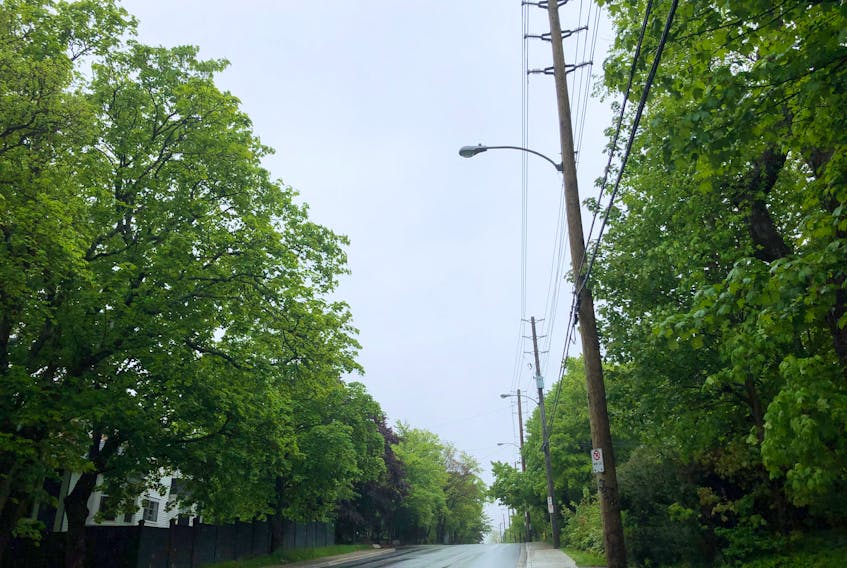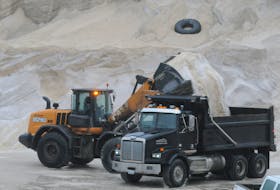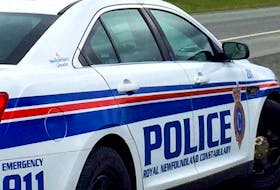ST. JOHN'S, N.L. — Looking out over St. John’s from Shea Heights or Signal Hill in the summertime is like viewing a green ocean with homes as skiffs and tall buildings for ships.
While the capital city is known for its heritage homes and structures, not so much is known about its trees.
A large portion of the city’s 440 square kilometres of land is dominated by native forest, but in some more densely populated parts of the city — especially in more recent developments prior to the 2018 requirement for new homes to have at least one tree planted on the property — trees are scarce.
Still, the city’s 2005 tree inventory identified 53,335 trees. The three most common were sycamore maple, Norway maple and white spruce. Unfortunately, the inventory did not capture the age of the trees.

City arborist Brian Mercer (no relation to this reporter) says that without knowing the date a tree was planted, its age can be tough to predict without cutting it down and counting its rings. He said this can also be done by boring into the stem and taking a core sample, but that creates an entry point for disease and decay, so the practice is avoided.
Still, Mercer was able to list for The Telegram some of the city’s oldest trees based on conversations he’s had with people who know some of the history of the area, and his own observations in assessing the size of the tree, which can be helpful in determining its age.
Mercer said many of the city’s big, old trees are located on private property where homes were built hundreds of years ago — some of which are still standing today, along with their trees.
“The species chosen — sycamore maple, Norway maple, horse chestnut, English oak, elm and beech — are all species introduced to the province, and likely selected by property owners as reminders of their homelands,” he said.
Some trees were noted by Mercer as qualifying as among the oldest in the city, but there are few details known about them, including the large European copper beech tree located at 34 Rostellan St., the tall pine tree at 644 Southside Rd., and various trees in the city’s oldest parks, Victoria Park and Bannerman Park.

Dunluce residence, 3 Renouf Pl. — Beech
In Vol. 1 of “The Book of Newfoundland,” published 1937, a section about Newfoundland flowers written by A.M. Ayre says: “At Dunluce the largest Beech tree in Newfoundland sweeps its great limbs over the lawn.”
According to The Newfoundland Quarterly, James Whiteford, a watchmaker, purchased the land on the west side of Portugal Cove Road in 1859. At that time, it was about one and a quarter miles from St. John’s (but today sits firmly within the city’s boundaries, of course).
The house still standing on that property today — on land facing Renouf Place — was built by the Whitefords as a summer retreat, according to the Newfoundland and Labrador Heritage Website. The home was named Dunluce after a castle of the same name in Ireland.
Whiteford’s sister, Isabella Whiteford Rogerson, was a poet. Many of her poems focused on the gardens around the home.
Her poem, “The Old Homestead — 1867” seems to highlight that appreciation:
"And at what would I value my elm and ash.
My sycamore, chestnut and oak? Well, I would not for a thousand more
Give them to the woodman's stroke; For a loved one, bidding adieu to earth.
Through a live-long summer, each day Sat 'neath their shade, as they rocked and swayed.
With the summer winds at play; And they soothed her soul and carried it up
Over sun and moon and star; And she loved the trees, and we love the trees.
And we see her wherever they are.”
King’s Bridge Road — Beech
Again in “The Book of Newfoundland,” Ayre mentions the trees on this street: “On King's Bridge Road, at Quidi Vidi, Carpasian, etc., are to be seen fine Beech trees, planted generations ago. The bark is smooth, the buds long and pointed. In spring the leaves are the most beautiful green imaginable. The edible nuts, called ‘Mast,’ contain oil.”
And in Vol. 7 of “Streetscapes” in 1984, King’s Bridge Road was called “an area of trees and tradition.”

“Wisdom Tree” at Margaret’s Place — Beech
“I’m not sure where the name originated,” said arborist Brian Mercer, when asked how the tree came to be known as the “Wisdom Tree.”
“I heard it’s because the tree is so old that, if it could talk, it would have a million stories to tell."
The bark has some carvings — initials and designs, and Mercer said this is common on urban beech trees because the bark is smooth.
Mercer said city staff identified the tree as one needing protection, and when newer developments went up in the area, staff worked with the developer to ensure the tree was retained.
In a Twitter post, Newfoundland folklorist Dale Jarvis called the tree “a living remnant” of the area’s lost formal gardens.

Cape Spear — Tuckamore
Tuckamore is a uniquely Newfoundland word for a tree growing along the coast, with its growth stunted by the harsh conditions. The trees hug the ground as they grow in line with the prevailing winds.
Don’t let their tiny size fool you into thinking they’re not old.
“I remember when I was in school, we were shown this one tree that was no more than a couple of inches high, and we were asked to guess how old it was,” recalls Mercer.
“Of course, we all said one or two years. And it was estimated to be probably about 25 years. And the way that happens is that trees can be suppressed by the conditions they’re in. So, a seedling sprouts on the forest floor and it sprouts up, and the idea is that it’ll wait there and it will just exist until the right conditions present themselves.
“The tuckamore grows on the sides of these cliffs, and places like out near Cape Spear, and it’s just completely stunted because of the wind and other conditions it’s exposed to. So, they just sort of exist in that condition and that state, and it almost preserves them. So, some of those things can be surprisingly old, even though they may be no more than four feet tall.”
Mercer said tuckamores are his favourite trees.
“I just think they’re so symbolic of the environment here on the Avalon, and I love their ability to thrive against the odds.”

6 Mount Cashel Rd. — White Poplar
Not much is known about the origins of this tree, but the current property owner is Paul Doucet. He said he’s lived at the property since 2009.
“From the very first day I got the house keys, I've received a regular parade of well-wishers advising me that I should ‘cut it down,’” he said.
“Maybe they're right. The roots mangle the driveway, the sap erodes the roof of my car, the bugs and the moss wreck my shingles, the sprouts pop in the gardens of my neighbours many houses over.
“I wouldn’t cut down the tree in a million years. The canopy is so big that it has to be trimmed back from the power lines on the opposite side of the street. It's a huge part of the fabric of the neighbourhood. The house and the neighbourhood wouldn't be the same without it.
“I feel lucky to be its custodian for now. Someday that role may fall to someone else. It has survived countless wind storms and hurricanes. One day its time will come. One forestry specialist told me years ago that the tree may already be dead. Hopefully the next generation of old growth trees in the neighbourhood will be ready to replace it when it finally falls.
“I don't think that there's enough attention given to collectively recognizing, preserving and growing the natural heritage of this city. It makes the city worth living in. We should be doing more.”

Bowring Park — Weeping Beech
On warm summer days, it’s common to see children playing in the shade under this tree’s large branches that span out over the ground like a wooden tent.
According to a document posted on the Bowring Park Foundation’s website detailing history of the park, this tree was planted in 1916, making it 104 years old.
Land for the park was donated by the Bowring Brothers trade and shipping firm in 1911 to commemorate its 100th business anniversary.
The park’s original design and construction began the following year. There are several trees noted to have been planted at the park in 1913, including white spruce, white pine and balsam poplar.

Government House grounds — Various trees
While the oldest trees on Government House grounds are located along the Military Road side of the property, not much is known about them.
Lt.-Gov. Judy Foote’s private secretary, David Brown, said he believes they were planted around the same time construction of the residence was completed, in 1831.
However, all of the trees on the vast part of the property facing Circular Road were planted by visiting dignitaries. A plaque mounted at the base of each tree describes who planted it, and when.
On the 22-acre property, there are trees planted by royalty, governors general, lieutenant-governors, prime ministers and premiers.
There’s a tree planted by Princess Diana in 1983 when she and Prince Charles toured the country.
Queen Elizabeth and Prince Philip each planted a Windsor oak tree when they visited in July 1978. During that same visit, Queen Elizabeth turned the sod for what became the Queen Elizabeth II Library at Memorial University.
And when the new university campus opened in October 1961, Eleanor Roosevelt handed over the keys as the guest of honour and personal representative of President John F. Kennedy. During her visit, on Oct. 9, she planted a tree at Government House, as did Prime Minister John Diefenbaker.
Brown said the public is welcome to walk the grounds at Government House and learn about the many trees planted on the property.

McLea Park off Topsail Road — Various trees
This is the site of the old Richmond Cottage, built in 1848, but demolished in 2017 to make way for new homes built by Wrightland Development Corporation.
It was a controversial development, and many area residents expressed concerns about the old trees on the 3.5-acre property — they urged the developer to keep as many as possible. A 2017 city document on the decision said the city arborist would work with the developer to minimize the number of trees to be removed.
Today, McLea Park is described on the corporation’s website as having 100-plus year-old trees which were “retained where possible to complement and enhance the neighbourhood composition.”

Difficult to protect old trees
Old urban trees face a number of challenges that make their survival an impressive feat.
Mercer said our province’s harsh climate, paired with climate change, presents some of the greatest challenges.
“With an increase in the frequency and severity of adverse weather events, a greater emphasis needs to be placed on ensuring our urban forest is healthy and resilient,” he said.
Protecting old trees from being cut down for development or other reasons is difficult.
Mercer said heritage legislation typically applies to items of historical or cultural significance.
“Old, mature trees are certainly significant, but in the absence of an associated historical attribute or event, they often don’t qualify for protection. Further, many of the large, significant trees in the city exist on private property, and the City of St. John’s does not currently regulate privately owned trees.”
He said in the absence of legislative authority, the city works with landowners to preserve trees through education and identification of alternatives that promote preservation.
Mercer said urban trees provide many benefits that can combat the effects of climate change, such as mitigating stormwater, blocking wind and providing shade.
“We need to ensure that as our city continues to evolve, we strive to ensure that trees and greenspace are part of that evolution.”









